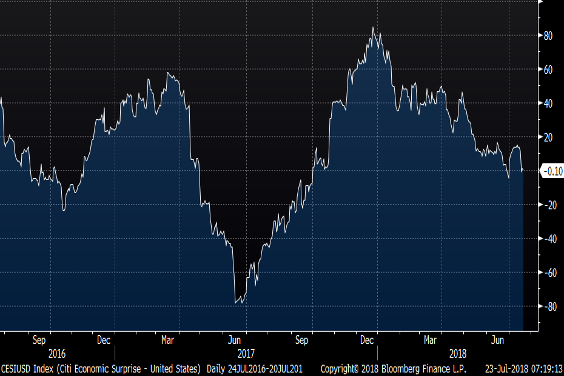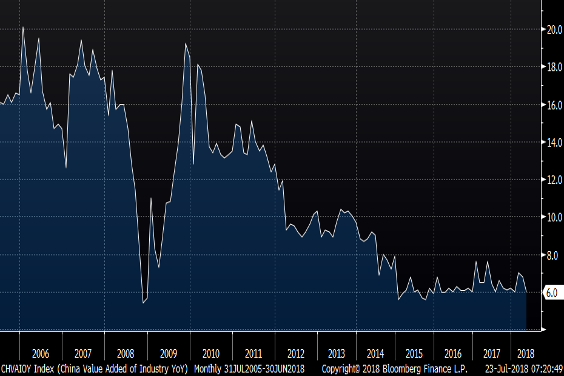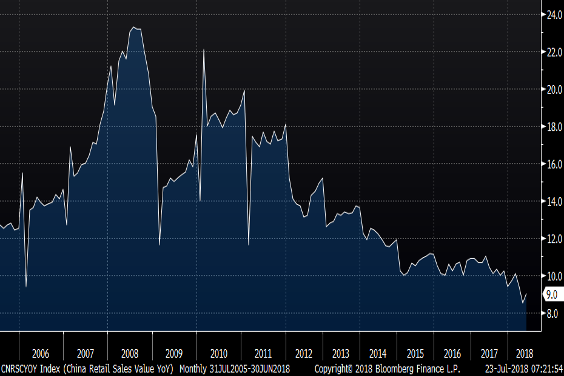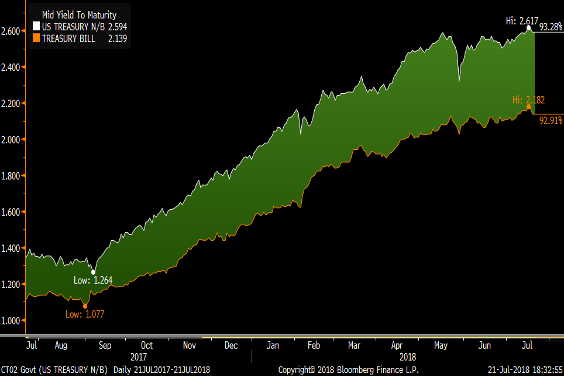by Doug Kass, Seabreeze Partners Management
'The boldness of asking deep questions may require unforeseen flexibility if we are to accept the answers.’ – Brian Greene
* A pivot in monetary policy, a further rise in the risk free rate of return, policy and profit uncertainty and a softening in soft and hard high frequency economic data are some of the reasons that point to a lower and destabilized stock market
Following The Great Recession of 2007-09 and a near collapse of the world financial system, the US and other developed as well as emerging economies embarked upon a near decade long expansion and global bull market. In large measure the recoveries were abetted by a worldwide coordinated monetary easing which took interest rates to generational lows and provided an unprecedented amount of excess liquidity.
Though US economic growth from 2009 to present remained substandard compared to previous recoveries, that excess liquidity provided a tailwind to higher stock prices. Corporate capital was increasingly allocated to buybacks rather than the more traditional capital spending outlays reflecting modest real growth in the domestic economy. Going back, since 1999 there were over 7500 listed securities on the NYSE and Nasdaq – today there are under 4000 listed securities (reflecting mergers, delistings offset by the proliferation of ETFs). And of the remaining listed companies nearly 20% of the outstanding shares have been repurchased.
Stocks clearly have benefited from this positive demand v. supply proposition.
If that was not enough, passive investing (ETFs) grew in popularity as did quantitative strategies — all at the expense of active investing. More than ever, investors worshipped at the altar of price momentum at a time in which the excess liquidity promoted optimism. Even central bankers (in Switzerland and Japan and elsewhere) joined in on the party – buying up equities with all that excess liquidity their central banks delivered as fear and doubt left Wall Street.
These factors – excess liquidity, company buybacks, the proliferation of ETFs and the dominance of machines and algorithms – all conspired together to produce an ideal decade for stocks.
The S&P Index famously bottomed at 666 in early March, 2009 (On CNBC’s Kudlow Report I called this a “Generational Bottom in Equities“ and made a high this year in late January (at about 2850).
Several successful probes back down to 2550-2600 were repelled and a few rallies ensued – markets moved back and forth and provided excellent trading opportunities for unimpassioned traders. We have recently moved back to 2800 – only about 50 handles lower than the highs seen earlier in the year.
Corporate profits steadily expanded throughout the last nine years and, thanks in large measure to a significant drop in the statutory corporate tax rate (the promise of which raised S&P price earnings multiples by nearly three points last year), S&P earnings are expected to hit a record high in 2018.
I believe that, after a near decade economic expansion and bull market, investors are no longer being compensated for taking risks.
Already this year (as a possible foreshadowing of the future) – and despite the appearance of a stellar profit picture – S&P valuations have contracted by nearly two points as the indices are only slightly higher than year-end levels. (Meanwhile the stock market in China, the engine of global economic growth, is signaling that problems lie ahead for that region – and in turn for those areas of the world that benefit from Chinese trade).
In essence, 2017 marked a year in which Wall Street outperformed Main Street while, thus far, 2018 marks a year in which Main Street seems to have outperformed Wall Street. After eight stellar years of Wall Street out performance (over Main Street), we may seen more than one year of contracting price earnings multiples in the year ahead.
I continue to believe that a 2018 high in the S&P Index was possibly reached in late January (call it “Peak Hope”) and will not be eclipsed for the remainder of the year. More importantly, I believe the market is now fully priced and vulnerable to much more downside than upside – and I have liquidated every one of my individual long positions (with the exception of (GLD) ). And I am maintaining my large (SPY) short.
Investing is a complicated mosaic – making decisions on only one or two factors often leads to a dangerous journey, particularly when effected when valuations and stock prices are elevated, when a market’s leadership seems to be narrowing and certainly with the recent emergence of a “two sided market” (from a formerly one sided and bullish market) which often leads to a one sided and bearish market. And, our investment world is more transparent and the transmission of news quicker and more universal than it has ever been. Communication is instantaneous and through a plethora of broadcasting and social media platforms we are almost all armed with the same information about at the same time. It is how we interpret and analyze that information and our willingness to be open to changing data is what sets our opinion and investment performance apart.
I worship not at the altar of price momentum but rather at the altar of security analysis and margin of safety. That process provides me with a relatively concise analysis of the relationship of reward and risk.
At the core of my near term concern are the deterioration (and worsening rate of change) in reward v. risk, the growing ambiguity of the trajectory of global economic growth, the pivot in monetary worldwide monetary policy, the likelihood of a steady move higher in short term interest rates (and a higher risk free rate of return), evidence of a loss of any fiscal responsibility (on the part of Democrats and Republicans), expanding policy risks in part based on the behavior of our President, the possibility of a “Blue Wave” in November and the evolution of a one sided (long) market structure (and a rising role of FAANG stocks).
I will touch on some of these immediate and more pressing concerns in this post.
* Downside Risk Dwarfs Upside Reward. I base my expected market view on the probabilities associated with five separate (from pessimistic to optimistic) projected outcomes that seize on a forecast of economic and corporate profit growth, inflation, interest rates and valuation.
On July 9th I wrote:
Add it all up and here are my expectations – you should view these S&P price forecasts not as precise, but rather as a guideline to overall strategy:
The Very Short Term
I expect the S&P 500 to go higher, but not materially so. A 2,750-to-2,800 trading range seems like a reasonable “guesstimate” to me. (Note: Mission accomplished – as we now stand at 2800!)
Given the above, I plan to scale into a net-short position on strength. However, I’ll give the market a wider berth and into the first few days of 2018’s second half, as I expect new investors inflows during that time.
Short Term (the Next 2 Months)
I predict that the S&P 500 will go lower, but not materially so. I expect a series of tests of the 2,675 to 2,710.
Intermediate Term (the Next 6 Months)
I forecast the S&P 500 will drop lower, with a break towards my estimated 2,500 fair-market value.
Here is my current calculus of reward v. risk:
Last week the S&P Index crossed 2800 – it closed on Friday at 2801.
- Current S&P 500 Level: 2801
- Fair-Market Value: 2,500
- Likely Trading Range: 2,550 – 2,750 to 2,800
- Market Downside: 2,400 to 2,450
Based on the above, I believe that:
(1) There are 375 points of downside risk to the 2,425 midpoint of my forecast for market downside, and virtually no upside reward to the 2,800 top of my estimate of the S&P 500’s trading range.
(2) There are 300 points of downside risk to my 2,500 estimate of the S&P 500’s fair-market value and virtually no upside reward to the 2,800 top of my estimate of the S&P 500’s trading range.
(3) There are 250 points of downside risk to my 2,550 estimate of the low end of the likely trading range and virtually no upside reward to the 2800 top of my estimate of the S&P 500’s trading range.
* Global Growth Is Less Synchronized as the trajectory of worldwide growth is becoming more ambiguous. I have featured the erosion in soft and hard high frequency data in the US, Europe, China and elsewhere extensively in my Diary – so I wont clutter this missive with too many charts. But needless to say (and seen by these charts and here), with economic surprises moderating from a year ago and in the case of Europe falling to two year lows – we are likely at ‘Peak Global Growth’ now. (The data is even worse in South Korea, Taiwan, Indonesia and Thailand).
Indeed there is now ample evidence that 2Q2018 will also represent ‘Peak US Growth’ – as a number of trade related benefits goose the soon to be released second quarter GDP.
(Note: Second quarter inventory accumulation was 4x compared to the average over 4Q2017 and 1Q2018, as companies try to secure lower cost product along the supply chain).
This cautionary view of trade tensions threatening global economic growth was confirmed in the G20 statement over the weekend:
‘Global growth remains robust and many emerging-market countries are better prepared to face crises, but risks to the world economy have increased, finance ministers and central bankers from the Group of 20 nations said in a statement published at the end of their two-day summit in Buenos Aires… The main risks are “rising financial vulnerabilities, heightened trade and geopolitical tensions, global imbalances, inequality and structurally weak growth,” the statement read. Emerging markets also face threats including market volatility and capital outflows, according to the G-20. The group’s March statement didn’t mention trade tensions.’
Both housing and autos are likely peaking, and the resetting of rates (higher) will further diminish growth prospects and provide a burden and headwind for those in the private and public sector that are stuck with variable rate debt. (Remember the debt bubble matters not until the rate rise accelerates – which is already occurring on the short end of the curve).
Meanwhile, despite protestations from the Administration, there is no evidence that the reduction in tax rates will trickle down – it’s likely to continue to trickle up to those individuals that possess large balance sheets consisting mostly of real estate and equities. This will have market and social ramifications.
Some charts in support of this view follows.
The Citigroup US Economic Surprise Index has fallen to zero (Europe is negative):
Source: Peter Boockvar
Chinese industrial production growth (year over year) is stagnating:
Source: Peter Boockvar
Chinese retail sales are dropping (year over year):
Source: Peter Boockvar
* FAANG’s Dominance Represents an Ever Present Risk.
“Yes. They (FAANG- Facebook, Apple, Amazon, Netflix and Alphabet’s Google) are great companies, but ETFs may have accentuated the flow of capital into those stocks…Things that are most hyped produce the most pain… A conspicuous number of ETFs are concentrated in the same stocks. When things go cold … who is going to buy it?… If and when it ends, it will end worse for the stocks that have had momentum and for the ETFs that hold them than for the rest.” – Howard Marks, Delivering Alpha Conference (July 28, 2018)
The dominance of FAANG stocks in the increasingly popular passive market (read: ETFs) makes the acronym (and market) risky as many of the ETFs are using the same “momentum” factor. Consider that just five stocks (FAANG) are a top 15 holding in 605 ETFs:
ETF Ownership of FAANG Equities
2018: 605
2017: 501
2016: 430
2015: 332
2014: 277
2013; 230
2012: 175
2011: 101
2010: 62
2009: 14
2008: 9
Source: Lawrence McDonald
Back to Howard Marks:
“The real big money in the investment world – the dependable money, the safe money – is made not betting that the things that have gone up a lot will continue but on betting that the things that have gone down and become unloved will rebound.”
The dominance of products and strategies (quant machines and algos) that worship at the altar of price momentum also represents a near term risk to the markets. As Marks says, whenever investors/traders are on one side of the boat, problems often arise.
Today the boat could capsize from the overwhelming weight on that side – should an inflection in momentum begin to occur.
That positive price momentum can change from numerous influences – here are some immediate and potential catalysts:
- Amazon’s (AMZN) aggressive vertical and horizontal strategy could be challenged by the President through a more modern interpretation of the Sherman Antitrust Act (which protects trade and commerce against unlawful restraint and monopolies).
- * An earnings disappointment of any FAANG member. (Already Netflix (NFLX) has recently whiffed on sub ads).
- * Tesla (TSLA) might have a liquidity issue.
- * Investors may begin to get worried about the large insider selling of FAANG.
- * Market Structure is Also One Sided and Worrisome Machines and algos rule the day – they too are momentum-based on the same side of the boat.
When buyers live higher and sellers live lower, anything that triggers the downside may accelerate the actual decline.
By contrast, I worship not at the altar of price momentum but rather at the altar of security analysis and margin of safety.
The distortions and dominance of quant strategies and the proliferation of ETFs have (arguably) diminished price discovery and materially reduced the market’s margin of safety.
* Higher Interest Rates Not Only Produces a More Attractive Risk Free Rate of Return, They Also Make It Hard for the Private and Public Sector to Service Debt
For nearly a decade, the Fed has pushed investors into long dated assets, like equities, with the T.I.N.A. mindset (“there is no alternative”). But this has changed in the last 12 months (Treasury bill yields are much higher on a year over years basis) coincident with the Fed’s pivot – as, for the first time in years, C.I.T.A. (“cash is the alternative”). Today the yield on the three month US Treasury note (1.98%) exceeds the dividend yield of the S&P Index (1.80%). Actually, the one month bill’s yield (1.85%) exceeds the S&P dividend yield.
Source: Bloomberg and Peter Boockvar
* Trade Tensions With China is Intensifying and Mr. Market Is Improperly Looking Past Marginal Risks From Goldman Sach’s David Kostin (h/t Zero Hedge). Remember, as discussed within this column, the dispute has buoyed second quarter US GDP. The “benefit” will soon be over and a 2Q economic cliff is possible.
* Any Semblance of Fiscal Responsibility Has Been Thrown Out By Both Political Parties This has very adverse ramifications (which may shortly be discounted in lower stock prices), especially as it relates to the servicing of debt – a subject I have often written about. Not only are our legislators acting irresponsibly but the Republican party is now considering more permanent tax cuts. Should economic growth moderate and tax receipts diminish – within the context of continued and undisciplined spending – stock valuations will likely continue to contract.
* Peak Buybacks. Buybacks Continue Apace But Look Who’s Selling As Grandma Koufax used to say, “Dougie, that’s quite a racket!” If I am correct about the peaking in corporate profits, higher interest rates and slowing economic growth, we will shortly have another rate of change negative in buybacks.
* China, Europe and the Emerging Market Economic Data All Signal Slowdown It’s in the early innings of such a slowdown based on any realtime analysis of the economic data. The rate of change slowdown (on a trending basis) is as clear as day. A rising US Dollar and weakening emerging market economic growth sows the seeds of a possible US dollar funding crisis.
* The Orange Swan Has Returned, Again Hastily crafted policy (delivered by Twitter) that conflates politics is dangerous in a flat and networked world. The return of an untethered Orange Swan is market-unfriendly … brace yourselves as the Supreme Tweeter will likely “Make Economic Uncertainty and Market Volatility Great Again” (#MUVGA)
Political tribalism in the US has overwhelmed reality and Trump is at the front of the line – an untethered and isolated President presents policy risks.
Astonishingly, over the weekend Trump again reversed his reversal and has walked back on his post Putin meeting correction on what the Russian involvement in the 2016 election was (we are back to “would” from “would not”) – again more destabilization from the White House:
Last night Trump went “Full Trump” (in capitals) again tweeted another bellicose foreign policy statement (more “fire and fury”) that resembled the initial brinkmanship and emotional outblast last seen with North Korea:
Finally, though I can make no conclusion as to the impact of the conclusions of the Mueller investigation – we are moving closer to its determination which could present another market risk.
We are also moving closer to the November elections – the uncertainty of outcome and the potential for a “Blue Wave” looms.
Regardless of the outcomes, the recent unhinged and unprepared behavior of the President (towards both our allies and enemies) holds first and second order risks and will likely impact markets and the risks of policy mistakes are growing ever more likely.
Bottom Line
“Freedom lies in being bold.” – -Robert Frost
For the reasons mentioned, it is my view that stocks made a yearly high in late January and we could be in a correction mode over the balance of 2018.
The list of possible political, geopolitical, economic and policy outcomes are multiplying now (many of them are adverse and market destabilizing).
I worship not at the altar of price momentum but rather at the altar of security analysis and margin of safety. This analysis suggests that the downside risks dwarf upside rewards.
After much thought I have liquidated all of my long positions and I have a large net short exposure now
Copyright © Seabreeze Partners Management




















